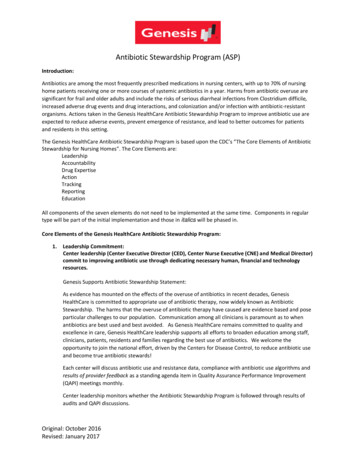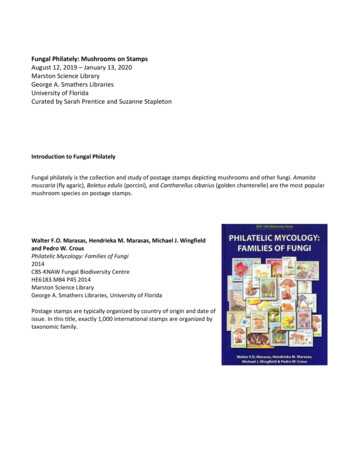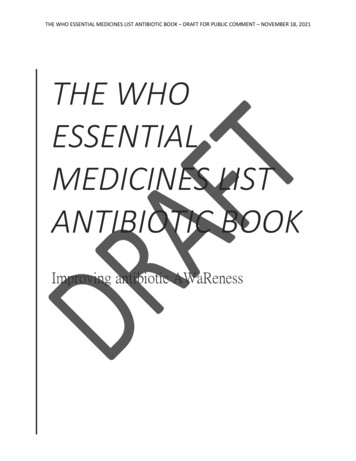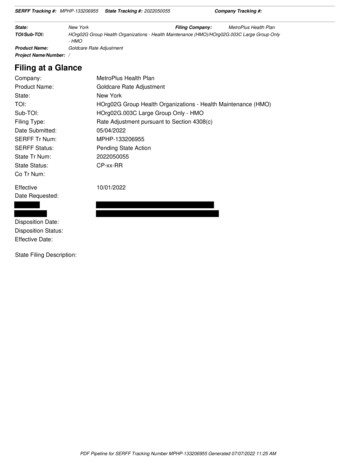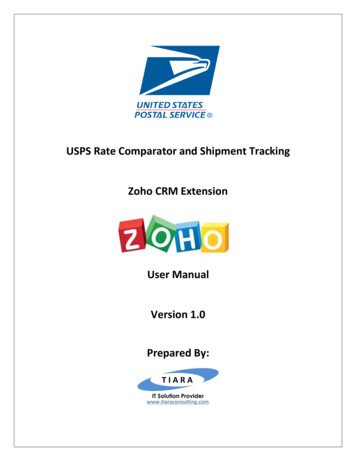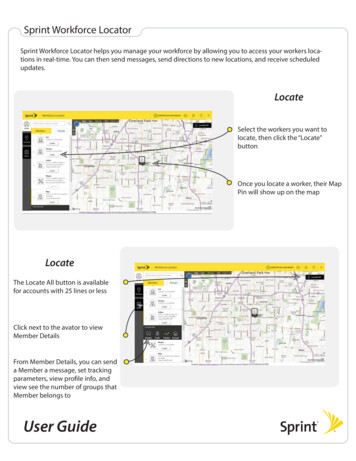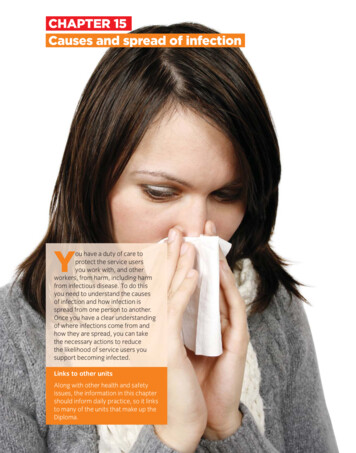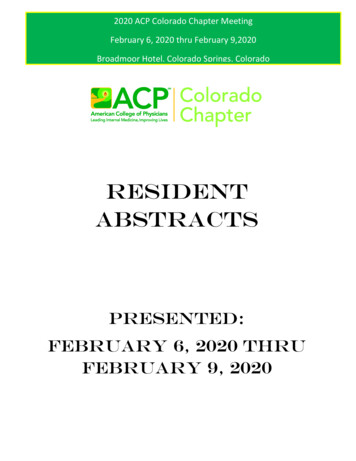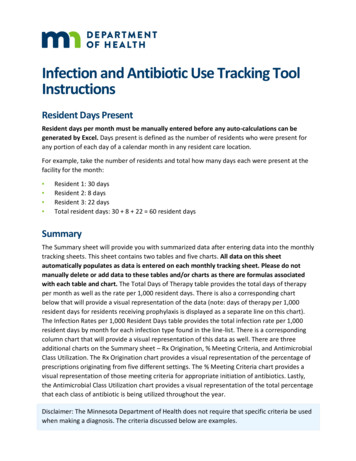
Transcription
Infection and Antibiotic Use Tracking ToolInstructionsResident Days PresentResident days per month must be manually entered before any auto-calculations can begenerated by Excel. Days present is defined as the number of residents who were present forany portion of each day of a calendar month in any resident care location.For example, take the number of residents and total how many days each were present at thefacility for the month: Resident 1: 30 daysResident 2: 8 daysResident 3: 22 daysTotal resident days: 30 8 22 60 resident daysSummaryThe Summary sheet will provide you with summarized data after entering data into the monthlytracking sheets. This sheet contains two tables and five charts. All data on this sheetautomatically populates as data is entered on each monthly tracking sheet. Please do notmanually delete or add data to these tables and/or charts as there are formulas associatedwith each table and chart. The Total Days of Therapy table provides the total days of therapyper month as well as the rate per 1,000 resident days. There is also a corresponding chartbelow that will provide a visual representation of the data (note: days of therapy per 1,000resident days for residents receiving prophylaxis is displayed as a separate line on this chart).The Infection Rates per 1,000 Resident Days table provides the total infection rate per 1,000resident days by month for each infection type found in the line-list. There is a correspondingcolumn chart that will provide a visual representation of this data as well. There are threeadditional charts on the Summary sheet – Rx Origination, % Meeting Criteria, and AntimicrobialClass Utilization. The Rx Origination chart provides a visual representation of the percentage ofprescriptions originating from five different settings. The % Meeting Criteria chart provides avisual representation of those meeting criteria for appropriate initiation of antibiotics. Lastly,the Antimicrobial Class Utilization chart provides a visual representation of the total percentagethat each class of antibiotic is being utilized throughout the year.Disclaimer: The Minnesota Department of Health does not require that specific criteria be usedwhen making a diagnosis. The criteria discussed below are examples.
INFECTION AND ANTIBIOTIC USE TRACKING TOOL INSTRUCTIONSMonthly Tracking SheetsPlease begin a new line for each infection being tracked. You may enter a resident name morethan once if there is more than one infection. If the resident is prescribed to more than oneantibiotic, begin a new line for that resident, but leave the Infection Type (column F) blank asyou do not want to count the infection twice.RESIDENT INFORMATIONTitleUnit NameResident NameRoom #Admit DateColumnABCDInstructionsIndicate the unit where the resident is located.Indicate name of resident.Indicate room number assigned to resident. Enter multiple locations ifresident moved to another room.Indicate date of first admission to the facility. This date remains thesame even if the resident leaves the facility (e.g., transfers to anotherfacility) for short periods of time ( 30 consecutive days). If the residentleaves the facility and is away for 30 consecutive days, the date of firstadmission should be updated to the date of return to the facility.CLASSIFICATIONTitleColumn InstructionsExisting InfectionIndicate if infection is an existing infection from previous month usingEfrom Previousthe drop-down. If the infection is existing from the previous month andMonth(s)? Y/Nhas been previously recorded on this line-list, do not fill in column F(Infection Type). This will prevent the infection from being countedtwice. Please enter the requested information in the antimicrobialstarts section to obtain accurate data regarding days of therapy (DOT).Infection TypeSelect an infection type using the drop-down arrow. If the type ofFinfection is not found in the drop-down list, select “other.”Body System ofSystem of body that the infection is associated with. This field will beGInfectionauto-populated when an infection type is selected. You will not be ableto enter free-text data in this field.SurveillanceSee Appendix K for surveillance definition. Appendix K: InfectionHdefinition met?Surveillance Definition WorksheetY/NHISTORYTitleSymptom(s)Onset DateDevice Type(s)(optional)Date(s) ofInsertionDate(s) ofRemovalDevice DaysInfection RiskFactors2Column InstructionsIDescribe the symptom(s) associated with the infection. For specificinformation on tracking symptoms, see Appendix J. Appendix J: Tips forApplying CDC's Infection Surveillance Guidance in LTCFsJIndicate the onset date (mm/dd/yyyy) of the signs and symptoms of theinfection.KIndicate the device type associated with the infection using the dropdown arrow.LIndicate the date (mm/dd/yyyy) that the device was inserted.MNOIndicate the date (mm/dd/yyyy) that the device was removed. If thedevice has not been removed, leave this field blank.Duration in days of device exposure (part of one day one day). Thisfield is auto-calculated.Identify any risk factors (not including devices) associated with theinfection (e.g., co-morbidities, chemotherapy, immunosuppressantmedication, etc.).
INFECTION AND ANTIBIOTIC USE TRACKING TOOL INSTRUCTIONSDIAGNOSTICS (MICROBIOLOGY, OTHER LABS, RADIOLOGY)TitleDiagnosticPerformed? Y/NTest DateType of TestSpecimen SourceResults(Organismcolony countsfor urine)AntibioticResistantOrganism? Y/NIf Yes, SpecifyColumn InstructionsIndicate if diagnostic tests have been performed (i.e., lab, x-ray).PQRUIndicate the date of collection or testing.Indicate the type of test (i.e., urinalysis, chest x-ray).Identify the source of which the specimen was obtained using the dropdown list. If not applicable (i.e., x-ray), leave section blank.Example: UTI-At least 105 cfu/mL of no more than 2 species ofmicroorganisms in a voided urine sample, positive influenza, orabbreviated x-ray result. See Appendix K for additional information.Appendix K: Infection Surveillance Definition WorksheetIndicate if antibiotic resistance is confirmed using drop-down arrows.VIf antibiotic resistance is confirmed, please specify.STANTIMICROBIAL STARTSTitleAntibiotic NameClassDoseRouteFrequencyProviderAntimicrobial RxOriginAntibiotic StartDateAntibiotic EndDateTotal Days ofTherapyMeets Criteria?Y/N3Column InstructionsWIndicate the antibiotic initiated using the drop-down list. The list ofdrugs in this list were obtained using the National Healthcare SafetyNetworks (NHSN) List of Antimicrobials. For more information, see CDC:Antimicrobial Use and Resistance (AUR) Module. Antifungal andantiviral drugs are not included in this list.XThis field will auto-populate when the drug name is selected. You arenot able to enter free-text in this field.YPlease indicate the dose of the drug being administered.ZPlease indicate the route of which the drug is being administered usingthe drop-down list.AAPlease indicate the frequency of which the drug is being administered.ABEnter name of provider who prescribed the antibiotic.ACIndicate the health care setting where the antibiotic Rx originated usingthe drop-down list (ED, Clinic, Hospital, LTCF, or Other).ADIndicate the date (mm/dd/yyyy) of which the antibiotic was initiated. Ifthe drug was started during the previous month, enter the first day ofthe current month.AEIndicate the date of which the antibiotic was ended. If the drug is stillbeing used, leave this field blank. In the event that antibiotic usecrosses over to the following month, enter the last day of the month inwhich the antibiotic was initiated. You will then enter the date for thefirst day of the month for the following month on its designated sheet.For example, if a resident begins an antibiotic on 1/2/18 but does notcomplete the antibiotic until 2/12/18, you will enter 1/2/18 as the startdate and 1/31/18 as the end date on the “January” sheet. You will thenenter 2/1/18 as the start date on the “February” sheet while leaving theend date blank until the antibiotic is no longer being used. Followingthese instructions will ensure that you receive an accurate numberwhen calculating the Total Days of Therapy for each month.AFTotal number of days receiving an antibiotic. This field is autocalculated when start date and end date are entered.AGMeets criteria of appropriate initiation of antibiotics. MDH does notendorse any specific criteria for initiating antibiotics. Example: SeeAppendix N: Minimum Criteria for Initiation of Antibiotics in Long-termCare Residents for clarification.
INFECTION AND ANTIBIOTIC USE TRACKING TOOL INSTRUCTIONSTitleColumn InstructionsAntibioticAHAn antibiotic “time out” prompts a reassessment of the continuingReassessmentneed and choice of antibiotics when the clinical picture is clearer and(Antibioticmore diagnostic information is available.“Time outs”)Performed? Y/NOtherAISelect the name of the other antimicrobial prescribed using the dropAntimicrobialsdown list. This list contains antiviral and antifungal drugs.Prescribed NameOtherAJIdentifies the class of the other antimicrobial drugs a resident may beAntimicrobialsprescribed. This field is auto-filled when another antimicrobial drugPrescribed Classname is selected.OTHER ed? Y/NIf Yes, SpecifyDate SymptomsResolvedColumn InstructionsIndicate if transmission-based precautions are required.AKALAMIf transmission-based precautions are required, please indicate the typeusing the drop-down list.Indicate the date when symptoms were no longer present.Printing of Data and ChartsPrinting lengthy spreadsheets such as this can be difficult as they are often too long to fit on asingle page. For this reason, we recommend using the Print Screen key or the Snipping Tool tocapture screenshots of reports and data you are interesting in presenting.Microsoft Support: Copy the window or screen contentsMicrosoft Support: Use Snipping Tool to capture screenshotsOnce you have an image of your screen, you are now able to save and print the image as is,copy and paste the image into other programs such as Word or PowerPoint, or include theimage in a report with other data or images.Resources 4MDH: Minnesota Antimicrobial Stewardship Program Toolkit for Long-term Care /antibioticresistance/hcp/asp/ltc/index.html) Appendix J: Tips for Applying CDC's Infection Surveillance Guidance in LTCFs bioticresistance/hcp/asp/ltc/apxj.pdf) Appendix K: Infection Surveillance Definition Worksheet bioticresistance/hcp/asp/ltc/apxk.pdf) Appendix L: Infection and Antibiotic Use Tracking Tool tibioticresistance/hcp/asp/ltc/apxl.xlsx) Appendix N: Minimum Criteria for Initiation of Antibiotics in Long-term Care antibioticresistance/hcp/ltcabxcard.html)
INFECTION AND ANTIBIOTIC USE TRACKING TOOL INSTRUCTIONS CDC: Antimicrobial Use and Resistance (AUR) Module cAURcurrent.pdf)Microsoft Support: Copy the window or screen contents fb9381b32bb7)Microsoft Support: Use Snipping Tool to capture screenshots 019For technical assistance or to obtain this information in a different format, contact the Healthcare-AssociatedInfections and Antimicrobial Resistance Unit at health.HAI@state.mn.us or 651-201-5414.5
INFECTION AND ANTIBIOTIC USETRACKING TOOL INSTR UCTIONS . 4 . Title Column Instructions Antibiotic Reassessment (Antibiotic "Time outs") Performed?

